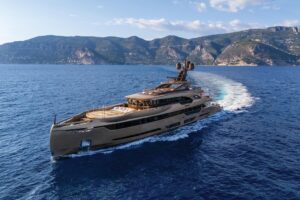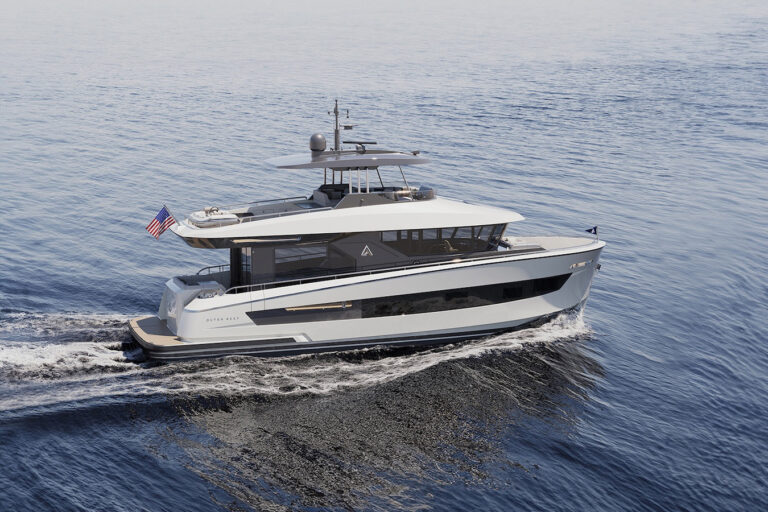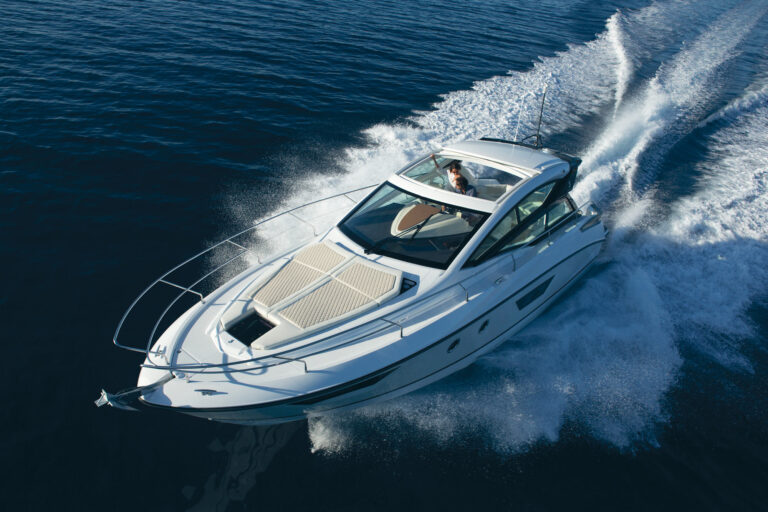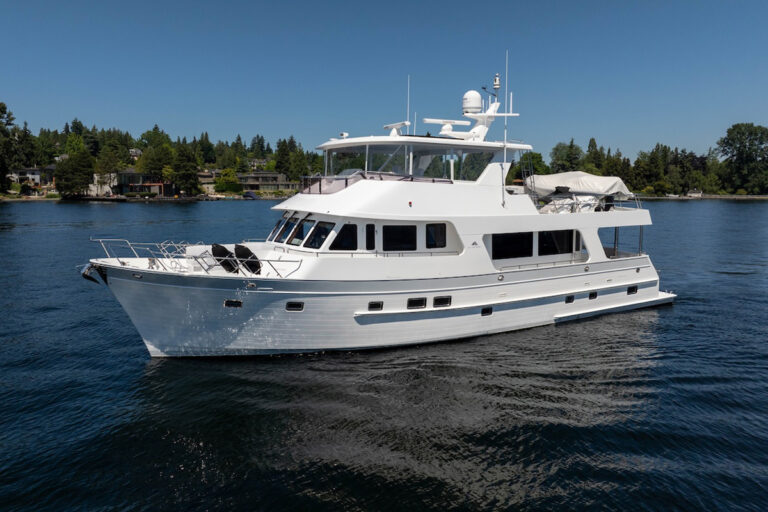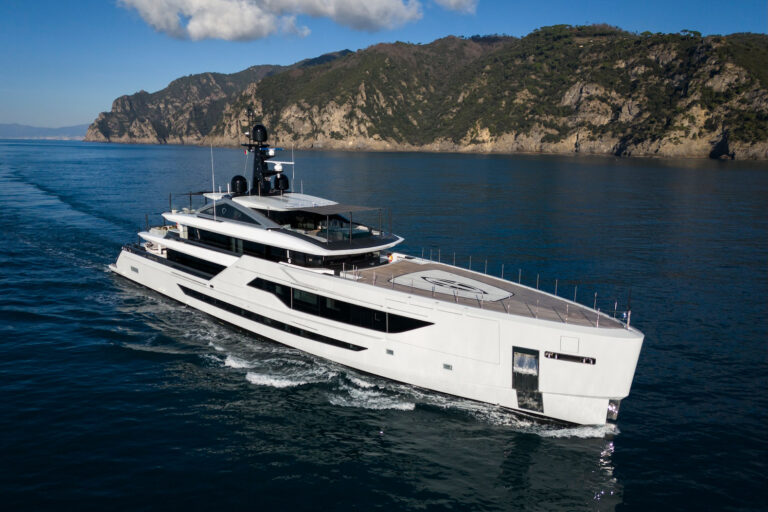
yachting/images/magazine/2007/012007/fea_scotland2_525x259.jpg
I thought I might have it rough on the first leg of my dream cruise of southwestern Scotland. An Atlantic low-pressure system was moving into the northwest and whipping up the Firth of Clyde. A large estuary that opens onto the North Channel between Ireland and Scotland and measures roughly 50 miles north to south and 25 miles east to west, the Clyde is defined by numerous lighthouses warning of dangerous shoals-all foaming violently in 20- to 25-knot winds and three- to five-foot waves. Could my chartered yacht prove equal to the buffeting?
Hours later the answer lay somewhere over my right shoulder and several miles away, where the gallant Cruisers 370 Express Howday! tugged gently at her docklines, secured against the pounding seas outside the Troon Yacht Haven’s breakwater. Now the worry was whether I would let her down. It would be a pity if the Cruisers 370 Express had brought me safely from Largs to Troon only to see me founder here, on the green shoals of the Old Course at the Royal Troon Golf Club.
Indeed, the moment of truth lay at my feet: a Titleist Pro-V1 golf ball in the gravest of predicaments. Somewhere in the distance was the sixth hole. Standing in the rough, in a mixture of shin-high grasses blended with copious doses of thistle and thorny gorse, I addressed the ball with a seven-iron in hand, electing to swing for the green rather than chip out safely into the fairway.
At that moment a gust of wind whistled through the rough and, involuntarily, I looked up at the most amazing panorama. Fifteen miles to the east, broken gray clouds trailing rain streamed off the top of the Isle of Arran and swept across the Clyde toward our foursome. I stood for a moment transfixed at the intensity of the scene, at the beauty of this course that runs along the edge of the bay and has hosted the British Open Championship eight times. Lightly, without any sense of effort, I pushed the club high and pulled it down and through the jungle at my feet. A gratifying ping reached my ears and I looked up to see the ball arcing toward the beautifully manicured green, bouncing once on the fairway between two crater-deep sand traps before coming to rest above the pin.
Modestly acknowledging the kudos of my colleagues, a father and son from South Africa and a gentleman from Australia, all of us thrown together to make a foursome, I took a triumphal stroll down the center of the fairway. Golf can be both gratifying and frustrating on virtually every hole, but I would remember this one-and enjoy doing so all the more at the bar of the Paramount Marine Hotel that adjoins the Royal Troon.
Call it Cruisers Karma, but a few hours later the dream was indeed realized as I sampled a selection of single malt scotch whiskeys-from the milder honeyed-tone tastes of Glenfiddich and The Glenlivet to the smoky saltiness of Talisker and Laphroaig, both from the Isle of Skye. (In truth, those were just the labels I recognized among a bevy completely new to me. With distinct whiskey-producing areas in every part of the country, and dozens of individual distilleries sporting histories that drill deep into Scotland’s storied past, the choices behind most any bar in Scotland are daunting-but appealing.)
Dinner that evening was memorable, a chance to share the day with my professional skipper and the photographer for this dream cruise. We dined at Scotts, a new restaurant overlooking Troon Yacht Haven, on appetizers that ranged from a hot oak-smoked salmon to a gateau of haggis, neeps and tatties (only in Scotland, laddie), then on to specialties like grilled Troon Harbour langoustines and steamed Shetland mussels. Even though fresh seafood was a specialty here, as it proved to be at all the restaurants we explored throughout our cruise, beef, wildfowl and venison were always on the menu, as well.
At dinner our charter captain, Tim Pearce, a Royal Yachting Association (RYA) Motor Cruising Instructor (one of 300 in the world), prepped me and Rich Hendry, our London-based photographer, for the morning’s passage. Tidal currents in this part of the world race up to six knots while the rise or fall can be as much as 20 feet. With little change in the weather predicted, it will surely get bumpy going to Tarbert on the western side of the Clyde. Pearce’s experience leading Scottish Cruises in Company for the RYA came to the fore as he suggested a course around the southern tip of the Isle of Arran, to minimize the angle we were bound to run against the prevailing wind and waves. We’d still see some rough water on the other side of Arran, but would eventually find comparative protection as we neared the lee of the craggy, verdant western peninsula known as Kintyre.
The next day proved to be every bit as challenging as Pearce had predicted, but his sharp eye and practiced hand kept the Cruisers 370 Express deftly moving around the really bad bumps. By mid-afternoon we arrived at the mouth of Tarbert, a well-protected harbor that has provided shelter to the herring fishing fleet since the ninth century. Tourism is growing in Tarbert, but the fishing heritage and infrastructure is still prominent, making the town a delightful place to explore and photograph. We caught a cab to nearby Stonefield Castle Hotel and Gardens, built in 1837 on a bluff overlooking the waters of Lower Loch Fyne, one of the headwaters. Stonefield is abundantly planted in rhododendrons collected in the Himalayas, rare shrubs from Chile, fuchsias from New Zealand, and even some impressive specimens of Sierra Redwoods. These and other conifers frame castle vistas looking out over the water, creating the perfect mood to match the comfortable and richly traditional accommodations, staff of friendly professionals, cozy pub and large dining room.
At Stonefield’s pub I sampled my first Whiskey Mac, made with equal parts of Crabbies Green Ginger Wine and a blended Scotch whiskey like Famous Grouse-a pleasant if unusual concoction, it went down easy and entered my pantheon of alternatives to scotch and soda. Talking with the bartender, I learned that single malts are made in comparatively small batches using three ingredients: local water; barley that is soaked, fermented and smoked; and yeast. Boiled and distilled, the whiskey is often aged in oak casks, some of which have contained sherry. The final flavor is a blend of all these elements plus the distiller’s skill and some less-than-obvious influences, such as the shape of the still itself. When I ordered a single malt from the shelf behind him, and asked for it on the rocks, he chided me gently and suggested that I try it neat first, then with a little flat water to appreciate the change in the smell and taste of the whiskey. That proved to be very good advice.
The following day, Tim Pearce took advantage of more protected waters to get the Cruisers 370 Express up on plane quickly and make tracks. We passed our intended destination of Ardrishaig at the beginning of the Crinan Canal, then relaxed a bit as we explored the farther reaches of Upper Loch Fyne. At its headwaters, tall mountains on either side sloped down to deep waters, providing a V-shaped backdrop of stunning green countryside dotted by large country houses and small farms proscribed by ancient stone walls. We doubled back to Ardrishaig late in the afternoon, entered Lock One of the Crinan Canal and were lifted to the pool just below Lock Number Two, where the boat would spend the night. Instead of taking the six-hour, 15-lock trip across this narrow portion of the Kintyre peninsula, we elected to hail a cab and spend the night ashore at the Crinan Hotel, with a magnificent bar overlooking Lock 15 and Loch Crinan.
Crinan Canal is often described as “Scotland’s most beautiful short cut,” a nine-mile link to the Western Isles (or Outer Hebrides), the isles of Skye and Islay, and also to the northwestern coast. It eliminates the need for mariners to transit the fast-moving and sometimes treacherous North Channel between Scotland and Ireland. It cuts across the historically significant stronghold of Scotland’s earliest kings, and runs through lands rich in architectural and natural importance. An engineering feat of the first order, it first opened in 1801, to steam-powered cargo vessels, and is today the home of numerous hotels and small businesses of every kind.
My own memories, however, will begin with the Loch Crinan Jumbo Prawns, netted and prepared the same day, that topped the menu at the Westward Restaurant in the Crinan Hotel. After such a succulent entrée, the ideal dessert to complement it appeared before me: a parfait of vanilla, slow-roasted figs and plums, with raspberry ice cream-followed by coffee and hand-made chocolates in the lounge. The staff was friendly and the service was outstanding. In one remarkable example, when one of our hosts learned that we would be leaving in the morning before the scheduled breakfast, he prepared a full spread especially for us.
That breakfast was indeed welcome when I awoke on the final day of our cruise to thick fog, yet by the time we had caught a cab back to Ardrishaig visibility was greatly improved. We locked down into Lower Loch Fyne, then set a course southwest that would take us through the narrow, fjord-like waters around the top of the Isle of Bute. As we motored north along the West Kyle and south along the East Kyle, boating traffic picked up-many others besides ourselves were taking advantage of these well-protected waters. We emerged into the northern reaches of the Firth of Clyde and set a course for Largs, where we would return the Cruisers 370.
It had truly been a dream cruise-one from which I was reluctant to wake up from. And so, as we passed between distant blue hills and green shores, I began to plan next year’s cruise, with a couple of days in each port, one or two golf courses at every stop, drives into the countryside, and more historic sites and fine restaurants. I’m sure my friends at Cruisers will understand.
Contact: Cruisers Yachts; www.cruisersyachts.com



